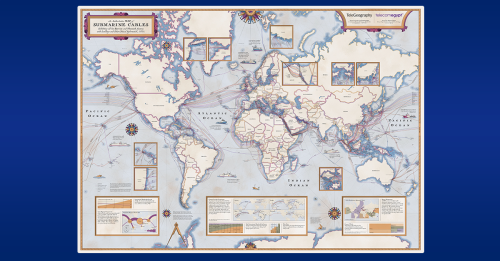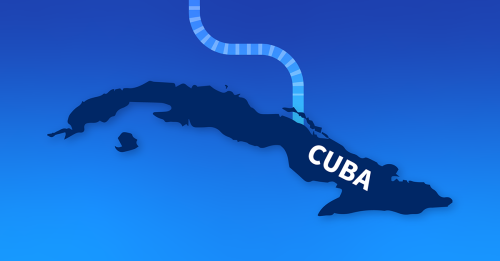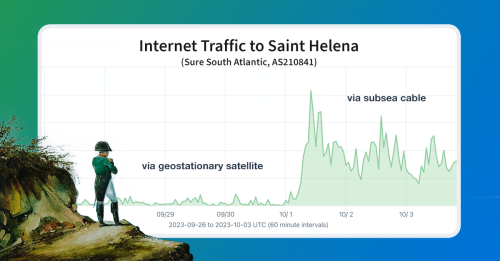
Summary
Just after midnight on October 1, 2023, the remote island of Saint Helena in the South Atlantic began passing internet traffic over its long-awaited, first-ever submarine cable connection. In this blog post, we cover how Kentik’s measurements captured this historic activation, as well as the epic story of the advocacy work it took to make this development possible.
Just after midnight on October 1, 2023, the remote island of Saint Helena in the South Atlantic began passing internet traffic over its long-awaited, first-ever submarine cable connection. Hours later, I published the first evidence of the submarine cable activation, continuing a practice of mine which has included the reporting the activations of the ALBA-1 cable connecting Cuba to Venezuela, the Tonga Cable in the South Pacific, and Kerch Strait cable connecting Crimea to mainland Russia.
If you’ve ever heard of Saint Helena, it might be due to its role as the final place of exile for Napoleon Bonaparte, beginning in 1815. Up until a couple of weeks ago, the 5,300 residents of this British overseas territory lived in an updated form of exile: from the benefits of high-speed internet access which define modern society.
In this blog post, I cover how Kentik’s measurements captured this historic activation, as well as the epic story of the advocacy work it took to make this development possible.
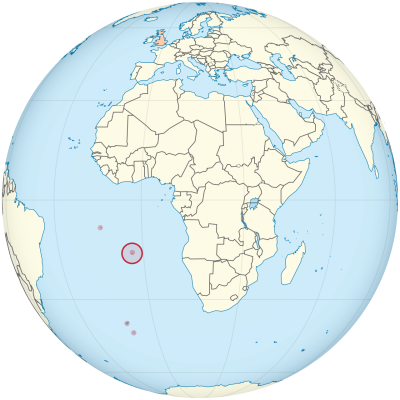
Evidence of the cable activation
Sure, South Atlantic (AS210841) isn’t just one of the ISPs in Saint Helena; it is the only ISP for Saint Helena. Sure also enjoys monopoly status in the other British overseas territories of Ascension and the Falkland Islands. More on that later.
In anticipation of Saint Helena’s cable activation, I had set up numerous synthetics tests in Kentik to measure latency to the island from dozens of our agents around the world. Below is an example of what one of those tests reported in the early hours of October 1.
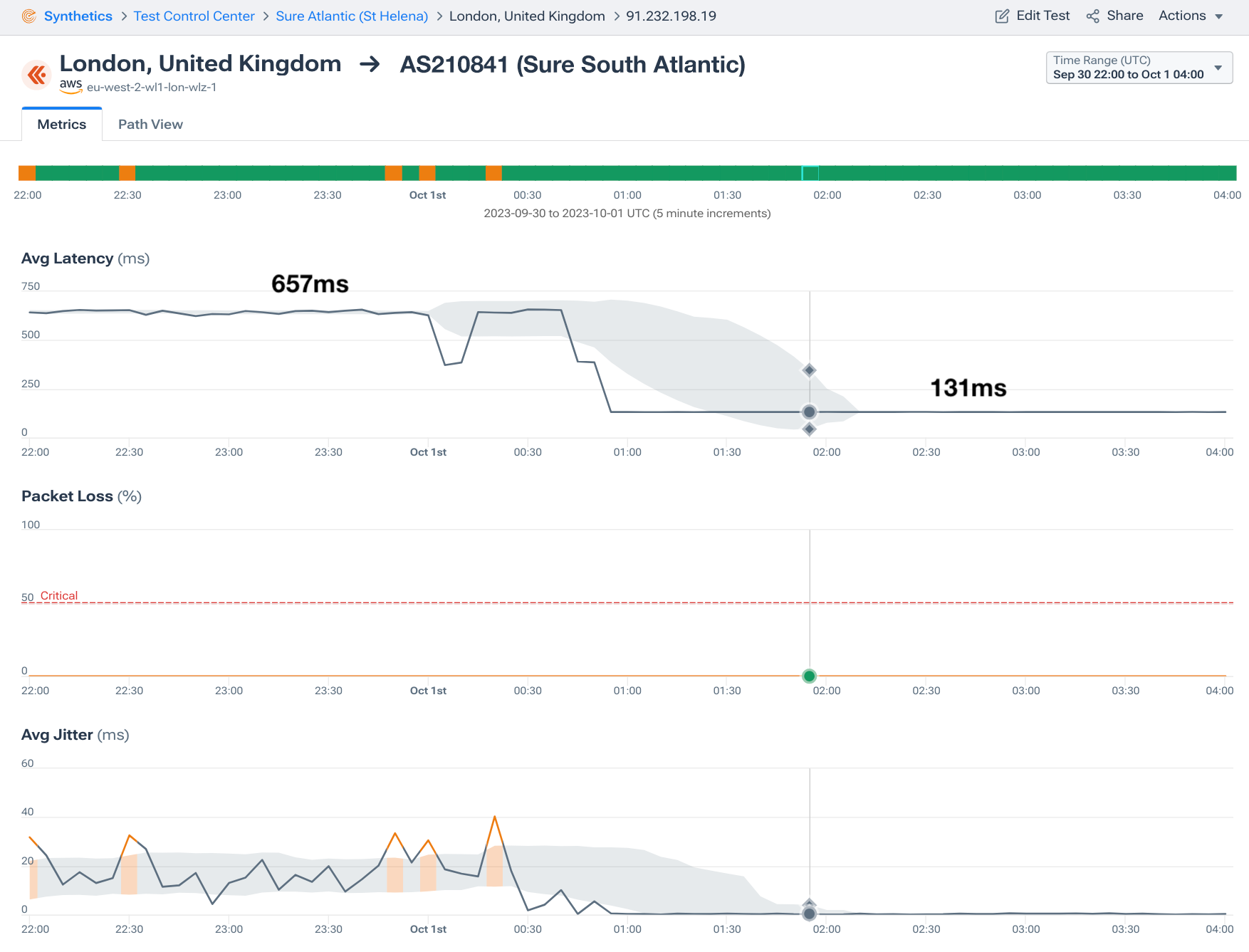
The screenshot above illustrates the dramatic drop in latency (from 657ms to 131ms!) from AWS’s eu-west-2 region in London to Sure (AS210841).
Due to the speed of light and the location of the orbiting satellites, it is impossible to attain a round-trip time (RTT) less than 480ms over a geostationary satellite connection. The observed drop in latency was almost exactly this constant value, which makes sense given it was due to the removal of a high-latency satellite hop.
The definitive guide to running a healthy, secure, high-performance network
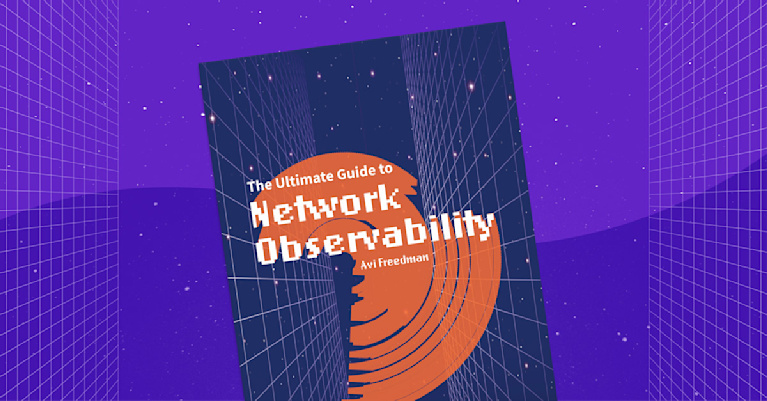
Furthermore, the switch to fiber optic connectivity evidently eliminated the jitter (variability in latency) that had been experienced over the geostationary satellite link.
Alternatively, latency from AWS’s region in Cape Town, South Africa (picture below) remains high despite a similar drop. Clearly, traffic is still required to make its way up to Europe before coming back along the Equiano cable.

The cable activation was also visible in BGP. Prior to October 1, satellite operator Intelsat (AS22351) was the sole transit provider for Sure (AS210841), colored in light green in the stacked plot below. Then, the upstream ASN changed from Intelsat to another Sure network (AS8680) — initially at first, and then permanently as the satellite connection was replaced with a submarine cable connection.

Lastly, the change was quite visible in traffic stats as well. We saw an enormous surge of traffic flowing to Saint Helena, based on Kentik’s aggregate NetFlow, as the submarine cable offered a huge increase in capacity versus the previous satellite connection. Our friends at Cloudflare reported a similar spike in traffic volume delivered to Saint Helena after the cable activation.
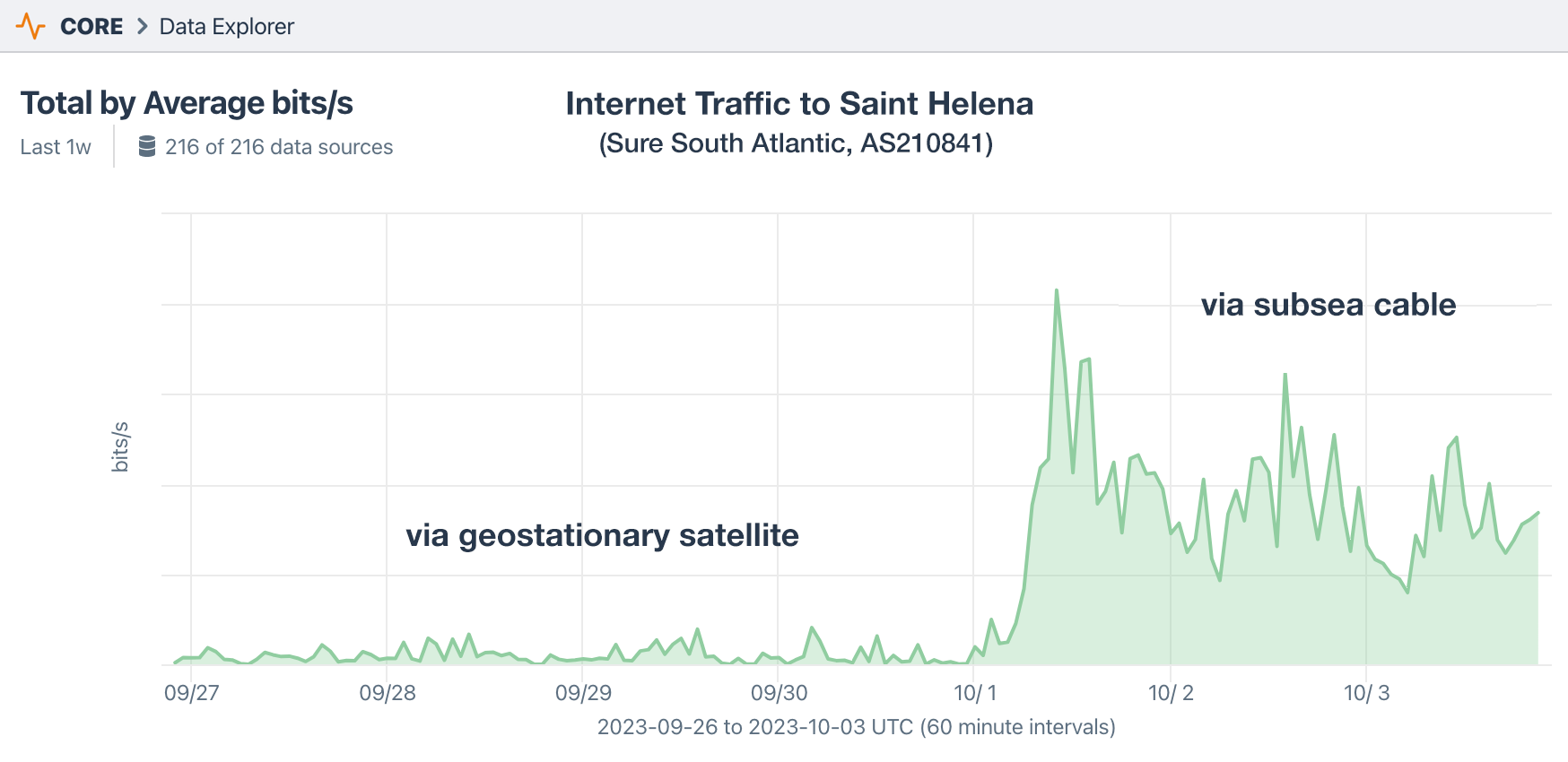
The story behind the activation
Saint Helena’s submarine cable connection would never have happened without a tireless lobbying effort spanning more than a decade. The leader of this effort was my good friend, German telecommunications expert Christian von der Ropp.
Christian first learned of Saint Helena’s situation from a childhood friend who spent ten months there in 2008. One of the most remote places on earth, Saint Helena was only reachable by boat until the UK government appropriated £200m to fund the construction of an airport on the island in 2011.
It is not uncommon for island nations to receive funding from development banks or similar organizations to construct an undersea fiber optic line to their shores. This was how Tonga got its submarine cable — the one that was also damaged by last year’s undersea volcano eruption. As I wrote in my blog post on that incident, development bank funding is necessary because cables to island nations are “thin routes,” i.e., cable projects unlikely to offer a return on investment. They are funded as development projects intended to help the local economy by enabling the connectivity necessary for modern society.
Unfortunately, because Saint Helena is a territory of the United Kingdom, it is ineligible to receive funding from organizations like the World Bank or African Development Bank. Like the airport, it would be the UK’s responsibility to fund a submarine cable connection. But also, like the airport, a high-speed internet connection would be essential to help to alleviate the many issues stemming from the island’s remoteness, putting it on a path to self-sufficiency.
Soon after the construction of Saint Helena’s airport, a South African company announced their plan to build a submarine cable through the South Atlantic called South Atlantic Express (SAEx) cable. The proposed cable would be the first to span the South Atlantic and run relatively close to Saint Helena. When Christian reached out to both the Saint Helena government and the South African company behind the cable, he found that neither group had considered the possibility of landing SAEx in Saint Helena.

Realizing that landing a submarine cable branch in Saint Helena wasn’t going to happen without dedicated advocacy, Christian founded the non-profit Connect St Helena in early 2012 and began the lobbying effort.
As part of this effort, Saint Helena islander James Greenwood submitted a petition to the UK government to fund a cable branch. While the petition failed to get the necessary 100,000 signatures to be taken up by the UK government, a British MP Andrew Rosindell filed parliamentary questions on the matter. This action attracted the first media attention to Saint Helena’s quest to have a submarine cable hookup
In 2015, the UK government expressed concerns to the Saint Helena Government (SHG) about the financial viability of a submarine cable serving such a small population. Particularly concerning were the ongoing O&M charges that would be required to maintain the cable. To address these concerns, Christian collaborated with SHG’s chief economist Tom Holvey to explore the possibility of attracting satellite ground stations to the island.
As earthstation.sh — a website Christian set up for SHG explains — by using the remote island’s submarine cable connection as a source of backhaul connectivity, a satellite operator could better serve large parts of the South Atlantic. The satellite operator would become a customer of the cable, contributing to its ongoing costs. Within a few weeks, Christian had received seven expressions of interest, including from OneWeb (LEO satellite operator and competitor to Starlink).
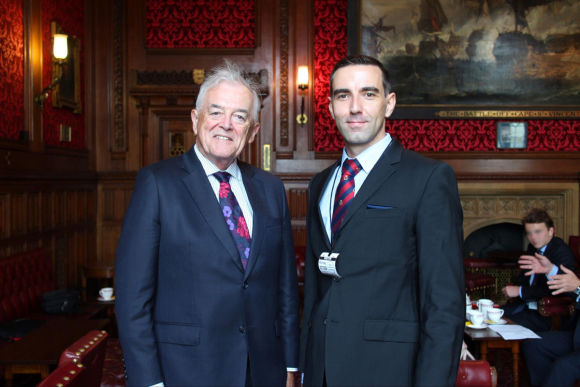
Christian shared the expressions of interest with two MPs: Andrew Rosindell (mentioned earlier) and Lord Richard Balfe, who each wrote formal letters to the Secretary of State for International Development, Justine Greening. These letters led the UK government to award the first feasibility study on the possibility of funding a cable to Saint Helena.
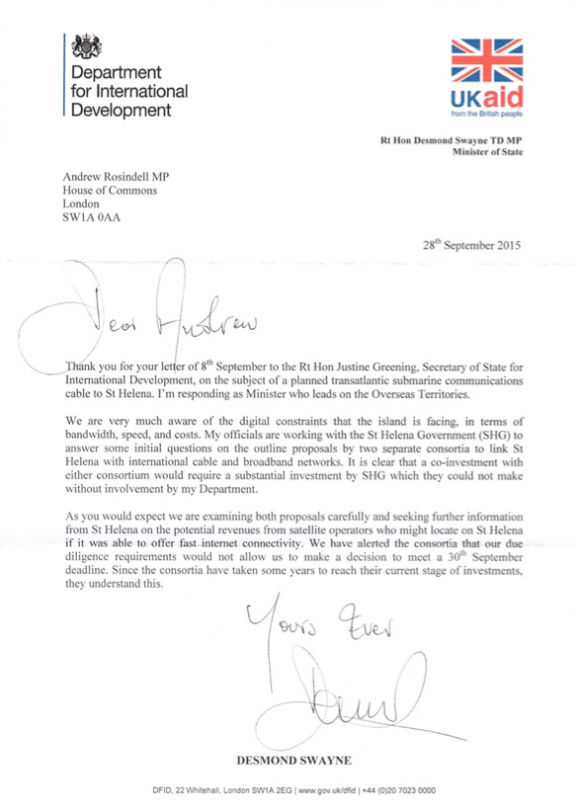
Despite the progress from the UK government, the SAEx project failed to raise the funding necessary and would eventually fold. Needing to find another submarine cable to connect to, Christian reached out to Angola Cables, who were in the process of building the South Atlantic Cable System (SACS) cable. In 2018, I would publish the first evidence of SACS carrying traffic across the south Atlantic, the first submarine cable to do so.
Unfortunately, Angola Cables was too late in the process of building SACS and would have required an upfront payment of $50 million within weeks — an impossibility for this project. Without a major submarine cable to connect to, the effort seemed to have hit a dead end.
Just when it appeared that all hope was lost, Christian heard rumors of content providers like Facebook and Google building new submarine cables around Africa. In January 2018, Christian wrote to Andrew Metcalf in the submarine cable division at Google, who revealed that Google was working on a new cable that would later become known as Equiano.

After realizing there was now another submarine cable project in the vicinity of Saint Helena, the SHG lobbied the European Development Fund (instead of the UK) for help. In June 2018, just six months after Christian’s initial outreach to Google, SHG received a grant of €21.5 million to cover the cost of building the cable branch connecting Saint Helena to Equiano.
While the UK had voted to leave the EU in 2016, the implementation of “Brexit” wasn’t finalized until February 2020. In 2018, the SHG was still eligible to receive EU funding. It would be one of the last EU benefits given to the UK.
The EDF grant was the final piece to the puzzle. It would cover the cost of the cable branch to Google’s Equiano and OneWeb’s ground station would contribute to the operational costs of maintaining the branch into the future.
The cable branch to Equiano was built from Saint Helena in August 2021, and initially, it just terminated on the ocean floor because the main trunk had yet to be laid. In May 2023, the branch was connected to the main trunk, and Saint Helena had a fiber optic link to the world, even if it was not yet carrying traffic.
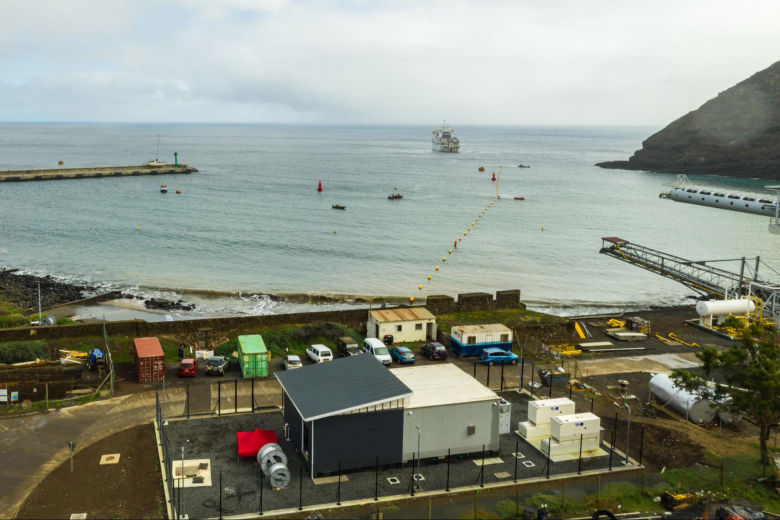
Earlier in this piece, I mentioned that Sure enjoys a monopoly on internet service in Saint Helena. That isn’t simply because it is the only local ISP, it is because it successfully lobbied the SHG to outlaw Starlink or any other competing source of internet service to protect its revenues.
As the only legal source of internet service on the island, Sure initially refused to make use of the new submarine cable connection as it risked the volume-based tariffs they were collecting from Saint Helena islanders. Sure only gave in and activated the high speed link to the Equiano cable when the SHG threatened to legalize Starlink, as the island of Ascension had done to spur Sure into action.
Conclusion
While internet service has improved exponentially in Saint Helena, tariffs are still quite expensive when compared to the average local income, and basic users face a data cap which seems hard to justify given the most expensive component — the submarine cable — was essentially gifted to Saint Helena by European taxpayers.
Lastly, Saint Helena islanders connect to the internet via ADSL2+ copper lines, meaning they rarely achieve more than 10Mbps download. The SHG began building their own FTTH network, but a major issue is Sure’s license to operate, which states that the SHG is required to compensate Sure for all its infrastructure if their exclusivity is not protected.
New internet connections don’t just happen by chance and this one faced enormous challenges, not all of which were geographic. It took over twelve years of lobbying to make Saint Helena’s submarine cable hookup a reality. Christian von der Ropp and numerous others on and off the island helped Saint Helena take a major step to eliminate their exile from the global internet.



